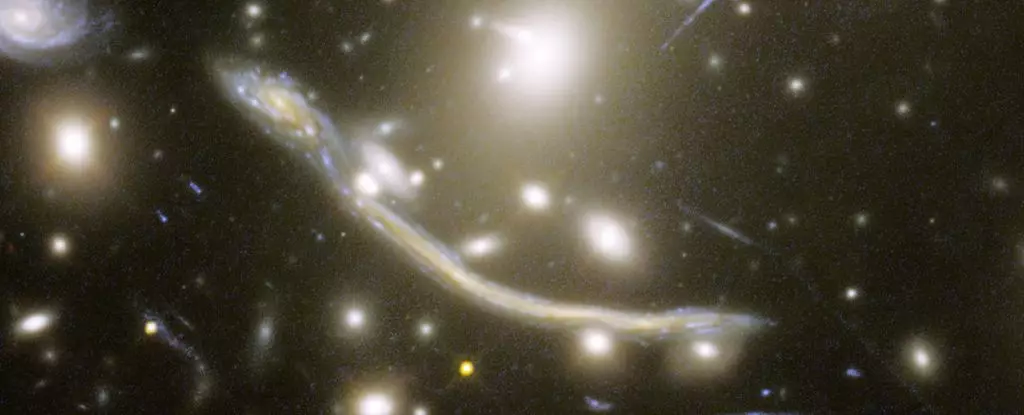In the vast cosmic expanse, the early Universe remains shrouded in mystery, presenting an immense challenge to astronomers longing to discern the secrets it holds. The light from galaxies that shimmer billions of light-years away has undergone a remarkable journey across the fabric of space and time, often becoming faint and elusive. However, with the advent of the James Webb Space Telescope (JWST), humanity has embarked on an unprecedented mission to penetrate these cosmic barriers, revealing intricate details of distant stars that were once deemed invisible.
Astrophysicists are celebrating a monumental achievement following JWST’s capacity to resolve and observe over 40 individual stars within a galaxy whose light has traversed nearly 6.5 billion years to reach us. As noted by leading researcher Fengwu Sun from the University of Arizona, this advancement signifies a groundbreaking leap in our ability to study large populations of individual stars in far-off galaxies. Prior to this achievement, studies using the Hubble Space Telescope managed to identify only a handful of stars—about seven in total—making the data collected by JWST not merely compelling, but also a game-changer in astronomical research.
This newfound capability is crucial for deepening our understanding of galactic formation and the elusive dark matter that permeates the cosmos, a phenomenon that previous findings were insufficient to elucidate. As more stars become observable, scientists anticipate that this vast dataset will allow them to draw more comprehensive conclusions about the structure and behavior of these ancient celestial bodies.
To appreciate the scale of this discovery, it is vital to understand the mechanics of gravitational lensing, a phenomenon that enables astronomers to glimpse the most distant corners of the Universe. Through the lensing effect described by Einstein’s theory of general relativity, the presence of large celestial masses distorts the space-time continuum, creating a framework through which the light from distant sources is warped and magnified. This creates a visual illusion, akin to viewing an image through a warped piece of glass.
One particularly striking example is the Dragon Arc, a name given to a stretch of distorted light resembling a mythical dragon in the night sky. This fascinating formation emerges from the gravitational lensing caused by a massive cluster of galaxies known as Abell 370, situated approximately 4 billion light-years away. The JWST’s impressive capabilities allow astronomers to dissect the complex light patterns emanating from the Dragon Arc, thereby reconstructing the true appearance of the galaxies that lie hidden within the cosmic fog.
As if gravitational lensing weren’t remarkable enough, JWST’s observations also come into play with another phenomenon—microlensing, which occurs due to individual stars drifting in the void between galaxies within the Abell 370 cluster. These rogue stars provide an additional layer of lensing, further enhancing our ability to discern distant celestial objects. Under the guidance of astronomer Yoshinobu Fudamoto from Chiba University in Japan, researchers have uniquely utilized this microlensing effect to uncover 44 individual stars swirling amidst the chaotic light that constitutes the Dragon Arc.
The initial goal was to locate a particularly distant galaxy whose light had been magnified by the gravitational effects of the galaxies presumably surrounding it. However, the delightful surprise of discovering a multitude of individual stars has sparked excitement in the scientific community. As Sun noted, this thrilling outcome has illuminated unexplored regions of cosmic history, significantly expanding our understanding of stellar compositions at great distances.
Further analysis revealed that many of the newly discovered stars are classified as red supergiants. These magnificent entities represent a terminal phase in stellar evolution—massive stars that have exhausted their nuclear fuel and expanded dramatically. Unlike their hot and luminous blue or white stellar counterparts, red supergiants are cooler, making them trickier to observe with traditional instruments.
The JWST has a uniquely capable sensitivity to red wavelengths, enabling the detection of these elusive stars. By shedding light on these cooler giants, astronomers glean insights into the lifecycle of galaxies far beyond our own—information that contributes to the broader narrative of cosmic evolution.
As we look to the future, we can hardly fathom the discoveries that await us. Armed with the capabilities of JWST, scientists strive to unveil more stars hidden within the distant Dragon Arc, allowing us to weave together the fabric of our Universe’s history and structure. The journey is ongoing, and with it, the promise of unveiling further cosmic enigmas is stronger than ever.


Leave a Reply